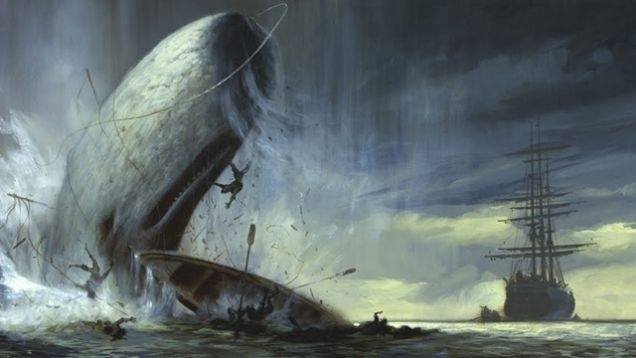moby-dick chapter 1 march 21, 21, 22
We’ll begin with a tour of the object you’ll carry on your person for the next two months; along the way, we’ll discover a bit about (1) what this novel attempts to do and why it’s so famous, (2) who this Herman Melville character is supposed to be, (3) why the whale’s name is Moby Dick, (4) why there’s a hyphen in the title of the book, (5) what Nathaniel Hawthorne has to do with a book he did not write, (6) the etymology of the word whale, (7) why we’ll pronounce the h in whale, and (8) each and every reference to a whale from Biblical times to the1850s.
We’ll then read together the great and glorious first chapter: “Loomings”.
Here is a handy document you might consider printing and having with you while you read: Allusions in Moby-Dick
HW:
For our next class, you’re reading chapters 1-3. You may find it useful to use the audio recordings from The Big Read; each chapter has a special guest reading it. Listening along will help, especially at the beginning. The readers are excellent at capturing the tone of each chapter, especially Chapter 3. As you read, seek out and consider the following concepts:
Water meditations and man's attraction to water, Ishmael's curiosity about and tolerance for human motivation, The quest, The nature of God and man, Finding and losing the self (Narcissus), Parallels between land and sea, Civilization and "savagery", cannibalism, Biblical echoes and references: Jonah, Job, Ahab, Elijah, Ishmael, etc.
moby-dick chapters 1-3 march 22, 23, 23
Today we’ll cover the history of the whaleship Essex and the extraordinary way Melville learned of the tale that inspired his novel.
We’ll discuss the first three chapters of the novel: Under what circumstances does Ishmael long to go to see? Why is he personally attracted to the experience of whaling? To what end does the novel use xenophobia and xenophilia? Is the scene with Queequeg supposed to be comic?
Let’s look closely at the beginning paragraphs of Chapter 3. What is ekphrasis? How is the painting at the beginning of the chapter a figure for the novel we’re reading?
How did you do with the first 3 chapters? What are the biggest obstacles to reading Melville?
At the end of class I will set your first vocabulary assignment.
moby-dick chapters 4-9 march 29, 28, 28
Today, before a discussion of chapters 4-9, let’s learn a bit about how this book came to be written: we’ll look at Melville’s life before 1850, Melville’s learning of the story of the Essex, Melville’s time on the Marquesas Islands, the passage of the Fugitive Slave Law of 1850, and Melville’s relationship with Nathaniel Hawthorne.
moby-dick chapters 10-15 march 31, 30, 30
Why do people turn to Moby-Dick in times of crisis? What’s a demagogue?
Then we’ll discuss chapters 10-15.
moby-dick chapters 16-19 april 4, 1, 1
During today’s class I’ll set your first writing assignment for Moby-Dick. Please remember to submit you vocabulary word list. Yes, there is a quiz today on Chapters 16-19, and you’ll need your knowledge of your words to succeed.
We’ll focus our discussion energy on Chapter 16: The Ship, especially as it pertains to (1) the contrast between Bildad and Peleg and (2) the initial description of Ahab.
HW: 20-26 for next time, please.
“There are certain queer times and occasions in this strange mixed affair we call life when a man takes this whole universe for a vast practical joke, though the wit thereof he but dimly discerns, and more than suspects that the joke is at nobody’s expense but his own.”
what's due?
April 4, 1, 1 — Vocabulary Set 1
April 8 — Creative Response to “Loomings”
April 14, 13, 13 — Vocabulary Set 2
April 25 — Passage Annotation and Analysis
April 28, 27, 27 — Vocabulary Set 3
May 5, 4, 4 — Thesis
May 10, 9, 9 — Original Chapter of Moby-Dick
May 18 — FULL draft
May 23 — Final essay










